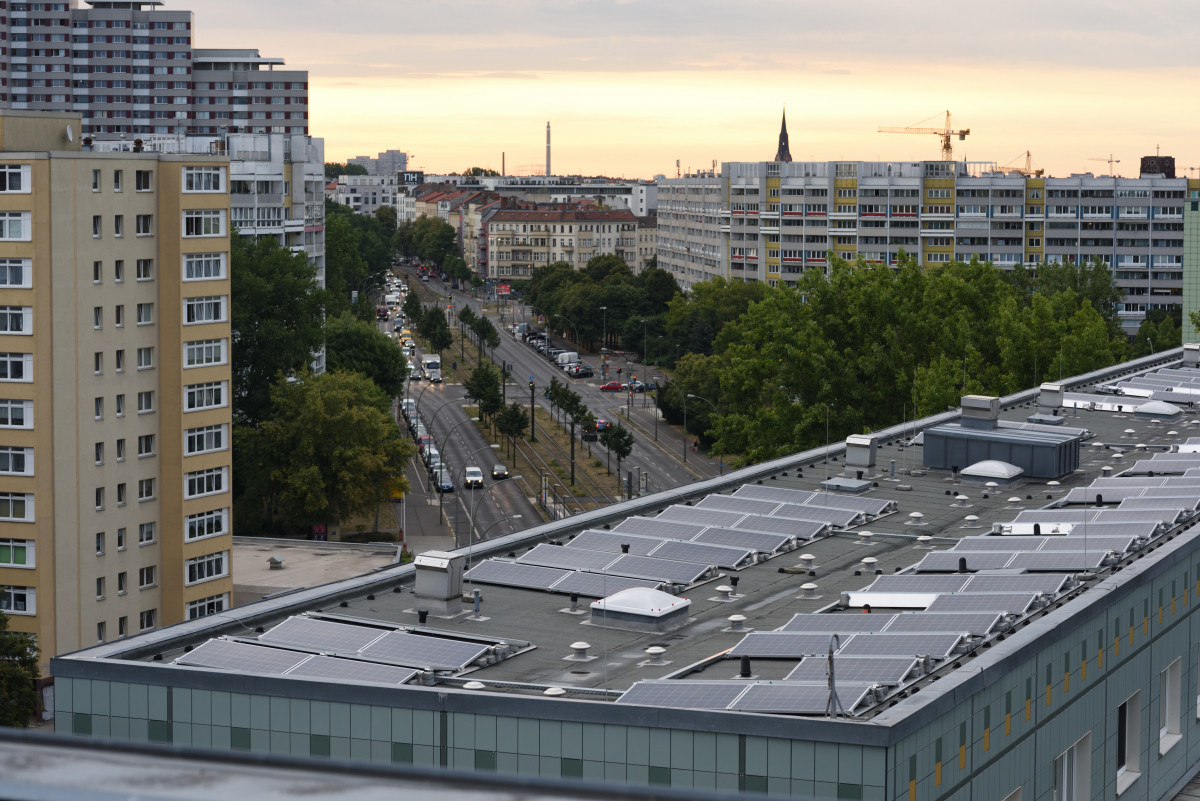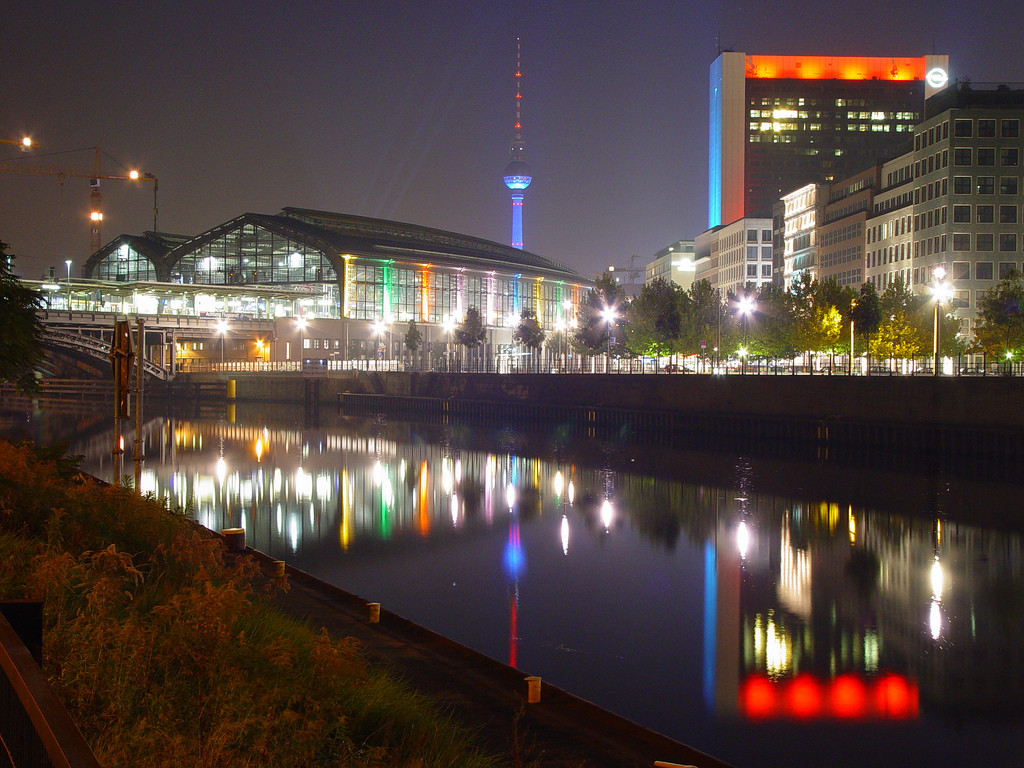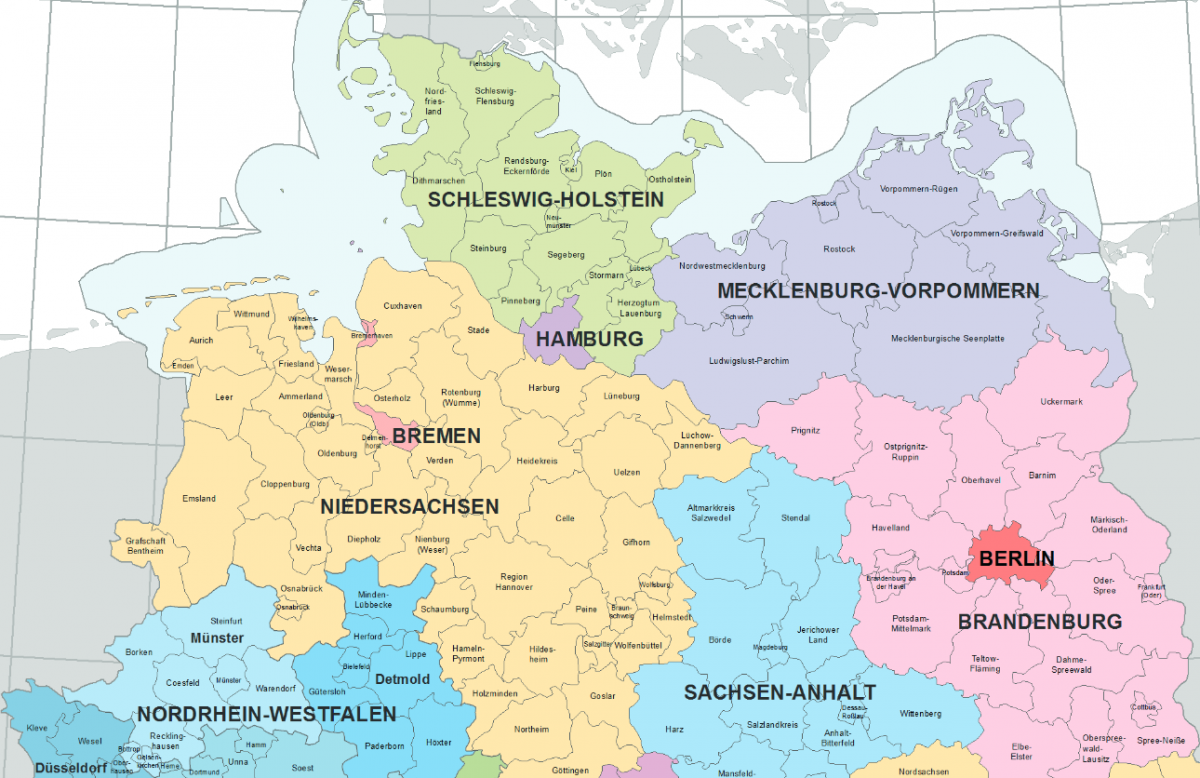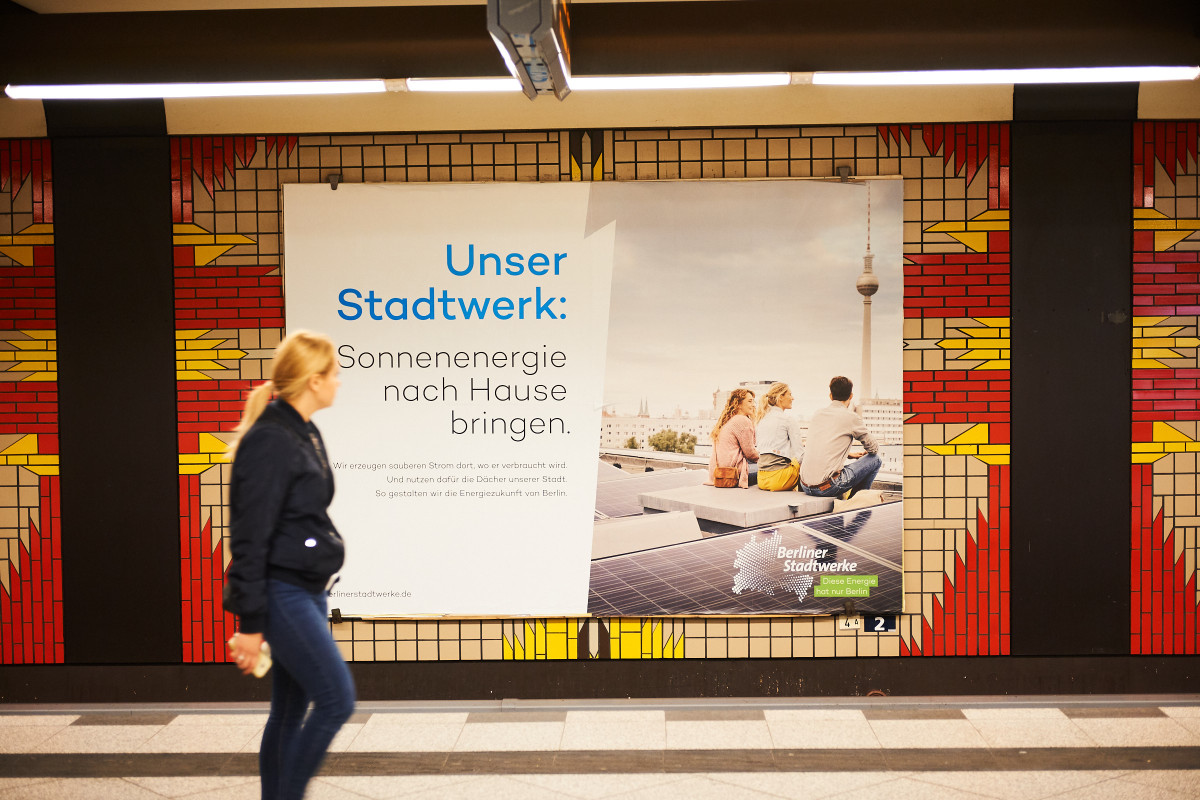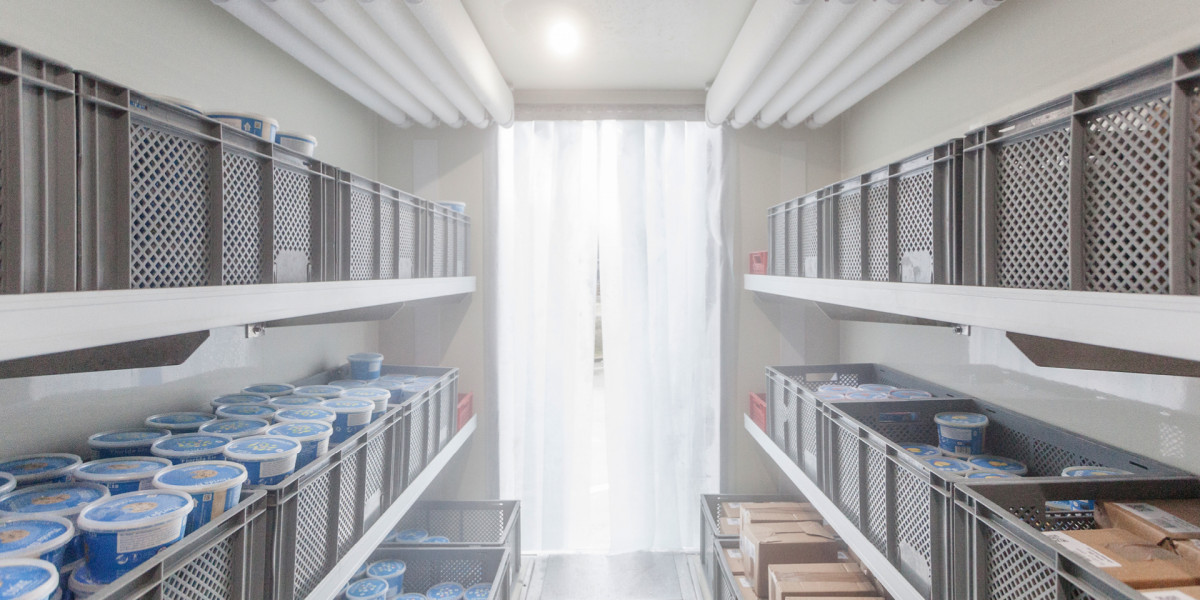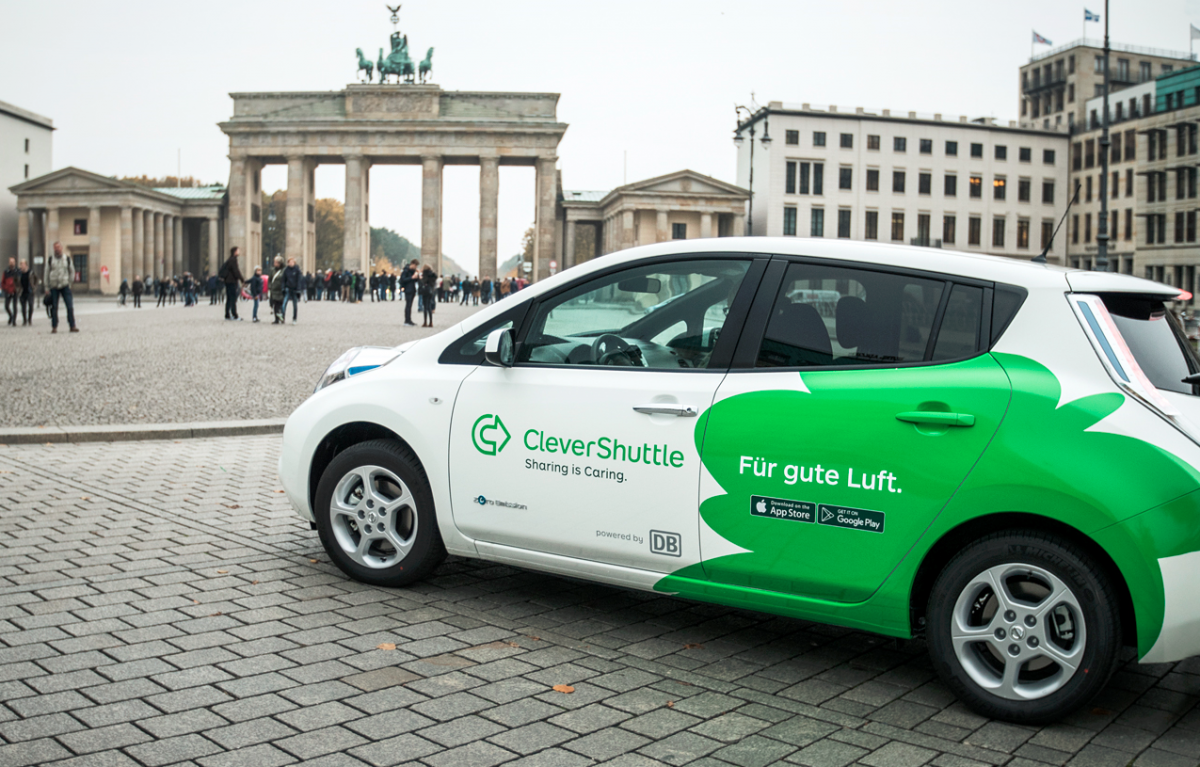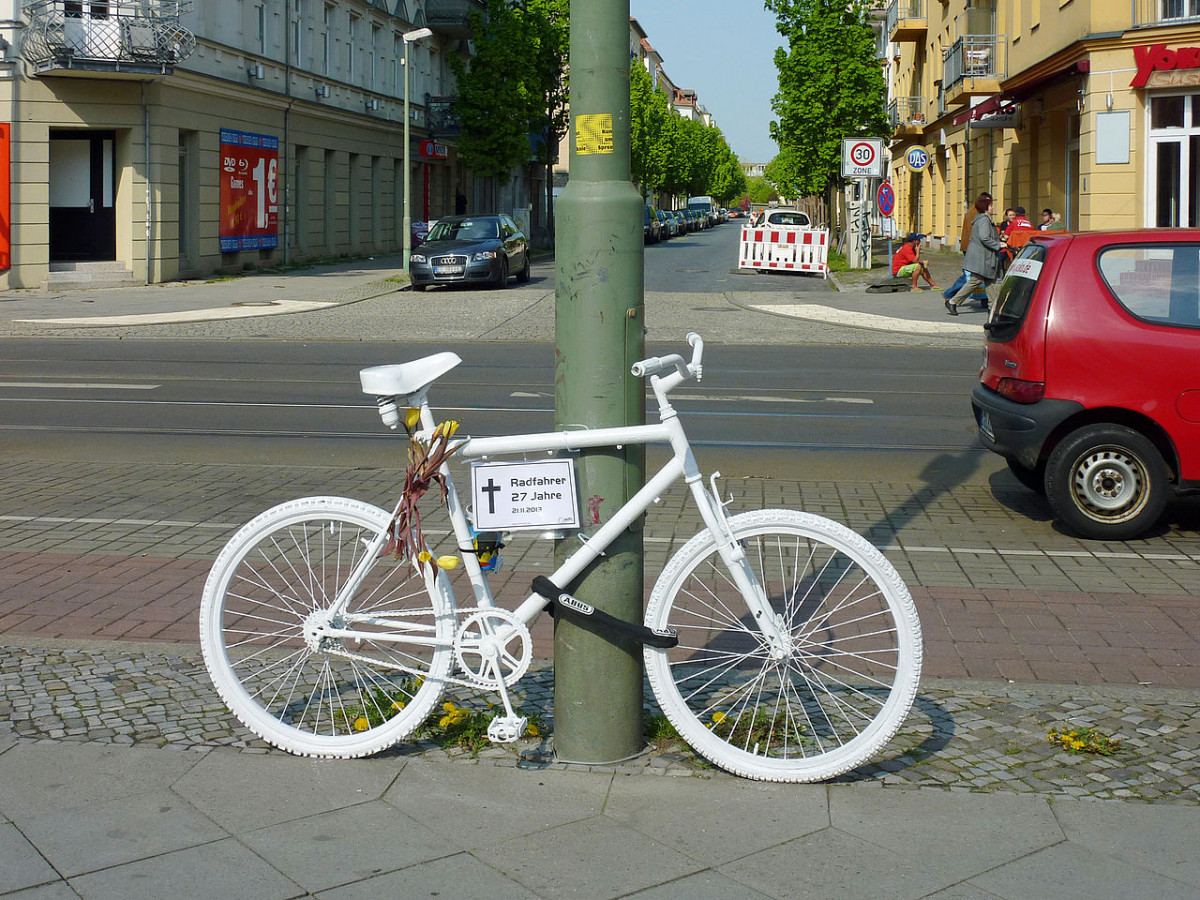City of Berlin shoots high with climate goals – but can it deliver?
Climate-oriented rethink underway
A stone’s throw from Berlin’s iconic TV tower lies Mollstraße, a bustling, downtown thoroughfare, lined with post-war communist-era modernist blocks. Constructed in the bombed-out city after WWII, the buildings were once the pride of East German Berlin. They’ve recently been given an environmentally minded makeover: One sprawling apartment block now has solar panels on its roof, supplying its 248 residents with green electricity and making it the city’s first listed building to become a power producer too.
The solar panels go unnoticed on the street below, where, aside from an occasional electric moped whizzing past or the nearby electric charging station, there is scant evidence of Berlin’s incipient Energiewende. But the revamp of the apartment block on Mollstraße is a small sign of the belated climate-oriented rethink underway in the metropole. And the blunt fact is: This exception needs to become the norm if Germany’s capital is to reach its ambitious climate targets, drawn up just down the street in the Red Rathaus, the seat of Berlin’s Senate.
Long a climate laggard, the city recently pinned down its environmental goals, with the headline target of making the city carbon-neutral by 2050. This plan may be outshone by other European cities, like Copenhagen, Denmark or Bristol, England, which aspire to climate-neutrality decades earlier, but the German capital, with its high profile on the international stage, has the potential to be an important municipal showcase for Germany’s national Energiewende. To fulfil this role, the city will have to upend its transport, electricity and heating systems, as well as many municipal political attitudes.
Steering Berlin towards its goals is a largely pro-Energiewende city government that took the helm in 2016, a coalition between the Social Democrats, the Left Party and the Green Party. Among its early moves wasquitting lignite coal in 2017. The government also aims to exit the remaining hard coal-fired power generation by 2030. Its blueprint for reaching carbon neutrality is the Berlin Energy and Climate Protection Programme (BEK), which requires the city to boost its generation and use of renewable energy, affecting transport, buildings and urban development, the economy and households.

We have laid a cornerstone for a climate-neutral city, across all departments, with the Berlin Energy and Climate Protection Programme.
On the frontlines of the transition, Berlin’s Senator for Economics, Energy and Public Enterprises Ramona Pop is determined for Berlin to take a national leadership role on climate. “We have laid a cornerstone for a climate-neutral city, across all departments, with the Berlin Energy and Climate Protection Programme,” she told Clean Energy Wire in an interview. “The State of Berlin is moving towards its goals and is showing the national government, which has practically given up on its ambitions in this direction, that climate policy is one of the most important tasks of our time.”
Ambitious shake-ups are also planned for transport, following years of underfunding and political water-treading. In 2017, Berlin became the first German state to create its own mobility law, which aims to boost cycling, public transport and zero-emissions mobility in general.
Among numerous non-profit organisations that make environmental benchmarks for cities, such as C40 cities, ICLEI and the Covenant of Mayors, the Carbon Neutral Cities Alliance lists Berlin among global metropoles with very aggressive targets. And, to its credit, the capital has decoupled its population growth from CO₂ emission, meaning it’s per-capita emissions are falling. In a global context, however, it pales against counterparts like Copenhagen, Stockholm, New York, or Portland, Oregon, which started pursuing climate targets earlier – and arguably in a more coherent way. Berlin’s emissions goals are now in line with the new pan-European targets. But the reality is that they will be hard to achieve in a capital with an entrenched addiction to fossil power sources and a reputation for being “poor but sexy”, a label coined by a former mayor, which has stuck for good reason.
A snap shot of Berlin’s energy use shows just how much needs to change if politicians are going to live up to their pledges. The German capital is one of Europe’s most populous cities, with 3.7 million inhabitants, and it is steadily growing. The city is taking pains to monitor its progress on carbon emissions, but, in 2015 (the latest available data), a mere four percent of total primary energy consumed hailed from renewable sources. When it comes to electricity, renewables made up just 2.5 percent of gross power consumption that same year. Even in domestic terms, Berlin is dragging its heels: Germany as a whole has already increased the share of renewables in power usage to almost 40 percent. But, after a string of governments preoccupied by the city’s numerous other post-reunification problems, there are tentative signs that Berlin is getting serious about addressing its climate footprint.
A legacy of division
Berlin, like most cities, is a densely populated, emissions-intensive metropole. At first glance, Berliners appear to be some of Germany’s most climate-friendly urbanites, triggering CO₂ emissions significantly below compatriots in cities like Hamburg and Bremen. This, however, is not a result of major policy efforts, but instead is a fluke of the city’s history. As a West German “island” in the middle of communist East Germany, Berlin lost many big industrial players during the Cold War. Then, after reunification, East German industry collapsed, accounting for a massive decline in carbon emissions of almost 40 percent in 2015 over 1990.
Berlin is also a city of tenants. More than eight out of ten Berliners dwell in rented flats, generally stacked in multi-story apartment blocks that consume less energy than the rows of single-family houses common in other cities. But Berlin – which emits around as much CO₂ as the whole of Jordan – still has a long way to go.
And buildings play a key role in the Energiewende, as they are responsible for around half of Berlin’s carbon footprint.Retrofitting the city’s building stock to be more energy efficient is a complex task, as landlords have little incentive to undertake costly upgrades to their homes and tenants fear rising rents as a result of such upgrades. Given Berlin’s acute housing shortage, landlords can easily rent their property, regardless of how renovated and energy efficient they are.
So far, the city government’s pledges tend to focus on subsidies and conscientious citizens who support the Energiewende – but observers complain that its measures are toothless. “In Berlin the problem is that we have no, or very few, legal tools to pressure people to improve building stock,” Matthias Krümmel, a Berlin specialist at Friends of the Earth Germany (BUND) told Clean Energy Wire. “We haven’t yet included climate proofing in our rental laws. Unlike us, other regions already feature concrete climate protection in laws on social housing construction.” Austria’s capital Vienna and Germany’s third largest state Baden-Württemberg are examples of places where all public buildings, including those with a “listed” status (which offers legal protection to buildings deemed of historic/architectonic value), must adhere to strict climate standards, he said.
Berlin’s renters can choose their own energy provider, meaning they can shop around and opt for green power.In 2014, a new option emerged in the form of the public utility Berliner Stadtwerke, one of Germany’s many municipal utilities, a small but powerful force in its energy landscape. Mollstraße, with its solar-panelled roof, is just one example of Berliner Stadtwerke’s tenants’ electricity project, which offers renters the chance to tap into locally produced renewable energy. Berliner Stadtwerke makes up just a slither of Berlin’s total electricity provision but its ambitions are big, as shown by its city-wide billboard adverts. “We use the rooftops of our city to generate clean power right where it's consumed,” reads the slogan alongside a picture of young people on a solar-panelled rooftop gazing at Berlin’s iconic TV tower.
Berlin’s growing populationmeans that pressure on resources – and energy – is also growing. It is estimated that at least 194,000 new apartments need to be built by 2030. This poses potential clashes of interest with the city’s climate protection pledges. For instance, Berlin’s Mayor Michael Müller (from the Social Democratic Party) recently sparked controversy by pushing for new housing on the capital’s biggest green space, the former inner-city airport now called Tempelhofer Feld — even though citizens have rejected such move in a referendum. Meanwhile, experts fear political calls for affordable rents could deter apartment owners from investing in energy-efficient retrofitting.
Green energy: Made in Brandenburg
Like other major cities, Berlin has limited space for local renewable power generation. But unlike many other cities, it can benefit from vast swathes of renewables production in the adjacent Brandenburg countryside. According to a recent study by the Berlin-based Institute for Climate Protection, Energy and Mobility (IKEM), the capital’s carbon neutrality could be effectively secured by Brandenburg, Germany’s fifth largest but relatively thinly populated state, which already ranks as a national renewables frontrunner.
Researchers compared production and consumption in the two regions and they matched in numerous ways, despite the intrinsic volatility of renewables. “It actually works out - and in real time,” IKEM’s head, Simon Schäfer-Stradowsky, told Clean Energy Wire. “A large proportion of Berlin's electricity needs could already be covered with green energy from Brandenburg.”
Within the city’s boundaries, however, renewable power production is limited mostly to biomass. In fact, solar, wind and other alternatives have long been overlooked, as underscored by the Agency for Renewable Energy’s recent conclusion that Berlin was second-to-last in a list of German states judged on their track record and enthusiasm for green energy.
Meanwhile, the city has just eight wind turbines, and solar accounted for a mere 0.8 percent of total generation in 2016. This low starting point made Berlin, by its area, Germany’s fastest growing solar-producing state in 2017. But, despite some high-profile exceptions, like the solar panels atop the capital’s central train station and the Bundestag, photovoltaic panels remain a rare sight.
But now it aims to catch up. On the Senate’s drawing board is a project called Masterplan Solarcity Berlin, a plank of its Berlin Energy and Climate Protection programme, which it has pledged to complete by summer 2019. Official estimates suggest that Berlin can do much more to boost the sector, estimating it has solar-suitable roof space equivalent to 3,600 football pitches. The state has already made a concerted bid to inform people about the sun’s inner-city potential, for example, with its November unveiling of a solar advisory centre to direct Berliners to the best technologies and architects.
But more needs to be done, says Volker Quaschning, a professor for regenerative energy systems at the HTW University for Applied Sciences, who oversaw research into Berlin’s photovoltaic track record. After probing Berlin’s legal system and ownership structures, Quaschning concluded Berlin was not set to strike its goal of covering a quarter of its electricity needs with solar as soon as possible. To reach that level, sticks would be needed as well as carrots: "We cannot afford to continue to put the brakes on climate protection,” he said. “If voluntary incentives do not work, the thumbscrews need to be tightened.”
This cleft between words and practice is a recurring theme in the city’s climate ambitions. To move forward, it needs enforceable rules. In August, Berlin’s Senate Department for Environment, Transport and Climate Protection passed a raft of measures on how to implement Berlin’s BEK climate pledges. But these do not yet go far enough. “With the BEK there is now a climate roadmap. But in reality it is a box of soft instruments,” Stefanie Groll, an expert on ecology and sustainability at the Heinrich-Böll-Stiftung in Berlin told Clean Energy Wire. “There are many campaigns and subsidies but few real sanctions against massive sources of CO₂.”
Carbon-neutral ice cream and start-up innovation
Across the city, a number of individuals and companies are moving faster than the state, reflecting a sharp appetite for a climate-orientated rethink. Florida Eis, in the Spandau district, is among the bright spots. The carbon-neutral ice cream manufacturer uses its large solar plant to chill its ice cream and power its electrical delivery lorries, earning it plaudits from the media and the government alike.
Many of the city’s start-ups are also setting a more ambitious pace. EUREF-Campus, in the Tempelhof district, is a former gas plant which has been revamped into a future-focused, clean-energy hub. Dubbed “the germ cell for climate protection”, the start-up and innovation centre has already struck Berlin’s 2050 goal of climate neutrality. And, change is also in the making on other side of the city. When Tegel Airport finally closes to make way for the city’s new airport in Schönefeld, its operating company Berlin TXL plans to swap its millions of CO₂-emitting aeroplane passengers for the Urban Tech Republic, a start-up base that will focus on energy and mobility.
But such forward thinking is still a pipe dream for Berlin as a whole. Today, coal remains vital for the city’s energy consumption, making up around a fifth of the total energy needed. The city has three big coal power stations on the grid and coal contributes around 40 percent of the capital’s heat via Berlin’s extensive district heating network, a system that pumps heat or hot water from a central source – such as a power station – to an entire neighbourhood or a group of buildings. Berlin’s district heating network is the third biggest in Europe after Moscow and Warsaw but it poses both challenges and potential for the Energiewende. Its efficiency as a system, using excess warmth made by power stations or by burning rubbish, makes it a good option for the city in the future, if it is switched to renewables. But that “if” is important. “We have our work cut out to manage to switch the district heating away from coal to using renewable sources. Here we face a big technical challenge which involves many actors,” said Krümmel, referring to “power to x” – using green electricity to generate the heat. “Right now, it is the big conundrum. No one is entirely sure how to proceed.”
Rethinking transport
Typically poorer than residents of other German metropoles, Berliners have far fewer cars per head than citizens of other German cities. But as in urban hubs worldwide, transport is a big contributor to Berlin’s carbon footprint, as well as pumping out high levels of local air pollution. In total it is responsible for around a third of CO₂ emissions.
But by 2050, Berlin wants transportation to be climate-neutral, a goal pushed through by Berlin’s Senator for the Environment, Transport and Climate Protection, Regine Günther, an independent politician who previously worked as a climate expert at Germany’s World Wildlife Fund for 16 years. This summer the Senate passed an ambitious new mobility law, seeking to end the city’s reliance on the combustion engine.
Part of this rethink is a move towards electric transport, walking and cycling. But Berlin has been a slow-starter, especially in an international context. A recently published ranking of the globe’s top 25 cities for electric vehicle sales included Amsterdam, London, Paris and Stockholm, but Berlin was nowhere to be seen. Right now, the German capital only has five electric buses. It has ordered 30 more, but this is far overshadowed by its fleet of some 1,500 diesel buses. In contrast, in the Chinese city of Shenzhen, the world’s electric mobility leader, most of the some 20 million inhabitants use electric public transport. In September Senator Günther and the head of Berlin’s public transport network BVG Sigrid Nikutta even travelled to China to make notes.
The big question is: Can Berlin deliver on its mobility pledges? On paper at least, the city looks good. The new transport strategy envisages more bus lanes and timed traffic lights for buses, while subsidies will help electrify delivery traffic and all buses and trains from 2030. But, obstacles loom in the short term, for example, the hefty price tag of electric buses compared to diesel and the need for a more extensive charging infrastructure.
Slowly but surely, however electric transport is becoming more visible, thanks in no small measure to the capital’s lively start-up scene. For example, the green and white cars labelled Clever Shuttle are increasingly visible on Berlin’s streets. The shared, electric-car shuttle service, founded by three school friends in 2014, uses algorithms to pool journeys, making it cheaper for passengers than conventional taxis. “When we founded the firm we realised it just doesn’t make sense to bring more diesel and petrol motors into the city anymore,” said a company spokesman.
Pedal power
Cycling is another buzzword in Berlin. Growing numbers of cyclists are squeezing into its crowded bike lanes, especially in the summer, and an overhaul of this infrastructure is long overdue. The Volksentscheid Fahrrad lobby group estimates that every three weeks a cyclist is killed on Berlin streets. This issue has left a mark on the cityscape in the form of “ghost bikes,” bicycles painted white, marking spots where cyclists have been killed.
The Berlin Senate’s mobility law seeks to prioritise and invest in safety – andconvince residents and visitors to make one-third of all journeys by bike by 2025. There is some early evidence of the 100 million euros aimed at expanding cycling infrastructure in Berlin in 2018 and 2019, for instance the fresh green paint applied to many cycle lanes (turning red at risky crossings). The first bike path separated from cars by a line of bollards was completed in November on a busy street in downtown Berlin. Similar routes are planned elsewhere, as are fast-cycling tracks and 100,000 bike parking spaces, including a large cycle-parking zone above Berlin’s central train station. Other bike routes have been less successful, including the much-mocked, impossible-to-navigate zig-zag bike path in Zehlendorf which was a hit on social media.
But meaningful change takes time, says Senator Günther, pointing out that protracted planning processes mean it takes an average of three years from the drawing board to finalising new bike lanes. As a relative newcomer to the Senate, she has also spoken out about clashes with the city-state’s bureaucracy, highlighting the problem of hiring new staff. InfraVelo, for example, which creates Berlin’s inter-district cycle networks, was only able to fill half of its 30 advertised vacancies.
Pro-cycle pressure groups are voicing impatience with the snail’s pace of change. Although they welcome the belated attention to bikes, advocates have pointed out that Berlin makes just half of Amsterdam’s investment on cycle routes per person. And catching up with Europe’s top bike cities will take more than euros and good intentions: Structural reform is needed at all levels of government. It is expected that the state’s apparatus won’t even manage to spend the money allotted for cycle-route improvements this year.
‘Poor but sexy’
This echoes a common story of the long-underfunded city administration putting the brakes on the state’s energy-transition reforms. Partly due to its divided history and its lack of industry, the capital buckles under almost 60 billion euros in debt. Berlin has the dubious accolade of being the only European capital that is a drain on the country’s overall economy – compared to economic motors like London or Paris.
For decades, administrations have had little scope to tackle pressing issues like decarbonisation and the greening of transport. In theory, this should change following the post-2016 political push for climate protection. Funding finally underpins the city’s aspirations – with around 100 to 169 million euros available annually from state coffers for the Berlin climate programme until 2030. But, similar to the city’s gradual creation of bike lanes, little of this has been tapped, even though applying takes just a few weeks. Delays have been blamed on civil servants with overflowing in-trays. “The day-to-day reality are huge delays and backlogs in the local building administration (Bauamt). They are not managing to get the employees. This needs to change if the state’s climate resolutions are going to happen,” said a city bureaucrat from a Berlin municipality, speaking on the condition of anonymity.
Part of the problem lies in the two tiers of government in Berlin. As a city-state, Berlin has both a Senate, which oversees regional politics, and its municipalities, which focus on local issues. Corinna Altenburg, an environmental specialist at the German Institute of Urban Affairs (Difu), said the state needs to tighten its links with its municipalities for effective climate-proofing. “Few Berlin districts have their own climate action plan, except for a few forerunners such as (wealthy southwestern suburb) Steglitz-Zehlendorf, nor do they have their own climate action manager,” said Altenburg, who previously worked at the Potsdam Institute for Climate Impact Research (PIK) and was involved in developing the city’s climate programme. However, she emphasised that it “points to a good direction” that some of the Senate’s investment has been earmarked for Berlin’s long-suffering districts.
And Berlin’s decarbonisation plan is also inextricably linked with the national government. For example, there has been national wrangling over diesel bans in cities, which directly impacts emission levels on Berlin streets. And there are repeated conflicts between national plans and Berlin’s laws. For instance, Senator Ramona Pop recently raged about a national move to tweak the energy law, which, by cutting subsidies, would harm Berlin’s bid to boost solar energy in rental accommodation.
"The federal government is strangling tenant electricity policy (Mieterstrom). We need to expand the tenant flow, instead of stifling it,” Pop said, adding that her department would fight to amend the national ruling.
I would like to see more. I’m impatient. We have a climate-protection gap in the city.
Meanwhile, the city’s slow progress towards carbon neutrality hits poor Berliners hardest. An official report showed how low-income populations take the brunt of car emissions, noise and a lack of green space. Stephanie Groll, from the Böll Foundation, suggested that health, alongside the climate, should shape policy. “Setting up car-free zones on heavily used roads would be a good example,” she said. “Those streets are often home to people who can’t afford to live elsewhere.”
And while Berlin’s political pledges are big, it remains to be seen how much of the Senate’s planned revamp of its transport and energy sectors will happen, and how soon. The fact remains that the Berlin climate programme is aimed at a broad cross-section of society. But despite positive exceptions, like Berlin’s zealous start-ups, Mollstraße’s new solar panels or the fleet of orange rubbish vans which pledged to go electric, other key actors are notably quiet on the subject of climate, irking those monitoring the city’s progress.
“I would like to see more. I’m impatient. We have a climate-protection gap in the city,” said BUND’s Matthias Krümmel. “At expert gatherings you see the same people and hear the same message, but when do you hear about it in the newspapers or on Berlin’s metro? There’s no talk about climate from the Hertha football team or Berlin’s Philharmonic Orchestra. Climate protection needs to happen across the board and I don’t yet see that widespread interest in change.”

